Value is always in the eye of the beholder, so the value of your Reflex depends on what buyers want.


Value is always in the eye of the beholder, so the value of your Reflex depends on what buyers want.
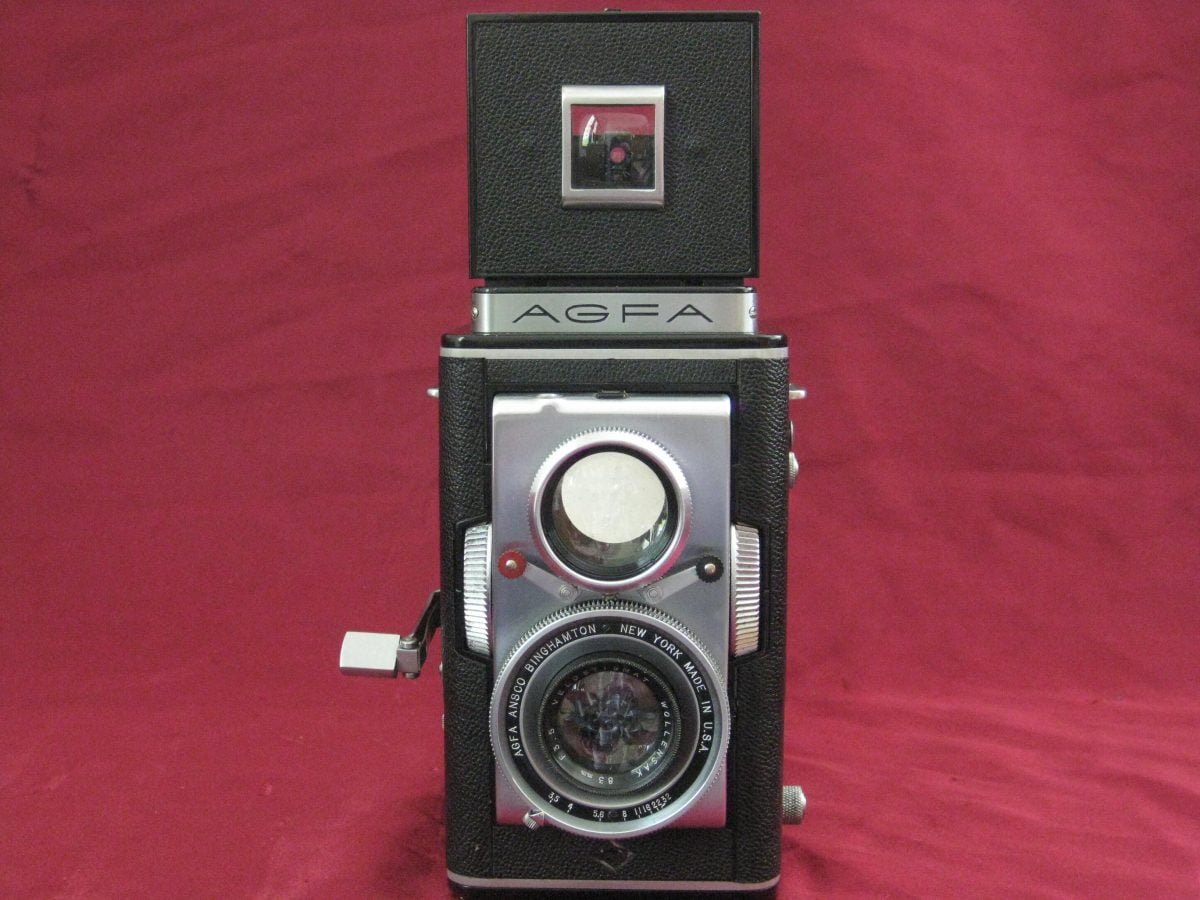
When Ansco announced the Reflex in 1945, their ads in trade journals claimed that the camera was “6 years old”. Those ads showed an all-black Reflex with many features in common with the production model.
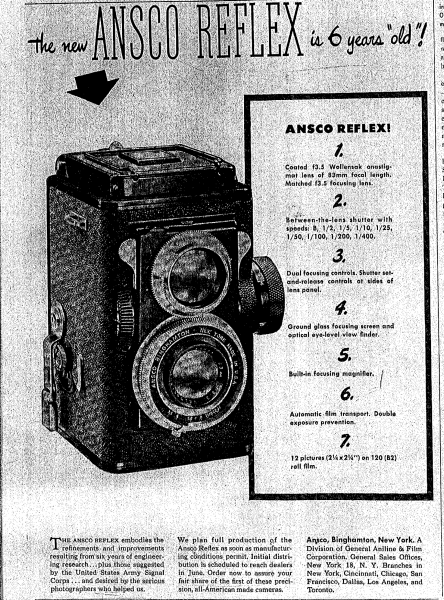
There is not a lot of evidence to support the claim. Government records don’t mention the Reflex until 1945. Ansco spent most of the war developing and producing war materiel.
A factor in the shortage of photographic equipment and supplies was the conversion of many manufacturing plants to the production of other war equipment. For example, Eastman stopped making cameras in 1941–1942, and began again only in a limited way in 1943. Ansco stopped soon after Pearl Harbor and throughout the better part of the war produced no photographic material except paper and film.1
In 1943, the Army Pictorial Service organized the Pictorial Engineering and Research Laboratory (PERL) to rede-
sign, improve, and develop better photographic equipment.
For the most part, PERL projects consisted of short-range modifications, improvements, or adaptations of existing items. The actual development work PERL accomplished either in its own laboratory, or through contracts with commercial concerns.2
Yet the Reflex did not spring from nothing in 1945. There had to have been some work in preparation. Ansco had two successive years of record earnings in 1938 and 1939. Flush with cash, it makes some sense that they would start to develop a camera to compete with the very popular Rolleiflex.
The answer to that mystery may be this prototype.
Ansco announced the coming Reflex in trade journals like the North American Retail Druggists (N.A.R.D.) Journal, Photo Trade News and National Photo Dealer. The ad listed seven features of the new camera and claimed improvements suggested by U.S. Army Signal Corps. PERL was a part of the Signal Corps and may have provided feedback to Ansco about the Reflex. I’ve not found direct evidence to support that yet.
Ansco, and General Aniline and Film, came under close scrutiny of the government with Germany’s invasion of Poland in 1939. In 1942, the U.S. government seized AGFA-Ansco as enemy property. The firm dropped AGFA from its name in 1943. This prototype, clearly labeled AGFA, was likely developed before the name change.
AGFA-Ansco lost a significant number of German and naturalized employees of German descent between 1939 and 1942, including key engineers and machinists. It’s not unreasonable to think that Reflex development began in 1939 and petered off as key engineers were dismissed. The intelligence gap created presented problems for General Aniline and Ansco in other areas, so the delay between announcement and production makes a certain amount of sense.
There are several details about this prototype, aside from the most obvious, that are immediately notable:
Other, less obvious exterior differences are:
There are a few details on the inside worth noting:
Last the everready case is stamped with the Agfa diamond logo on the front, just below the taking lens.
It’s clear from the numerous small differences between this and the production models that it’s a prototype. Exactly when it was made is hard to pin down but an abundance of clues point to sometime before 1943.
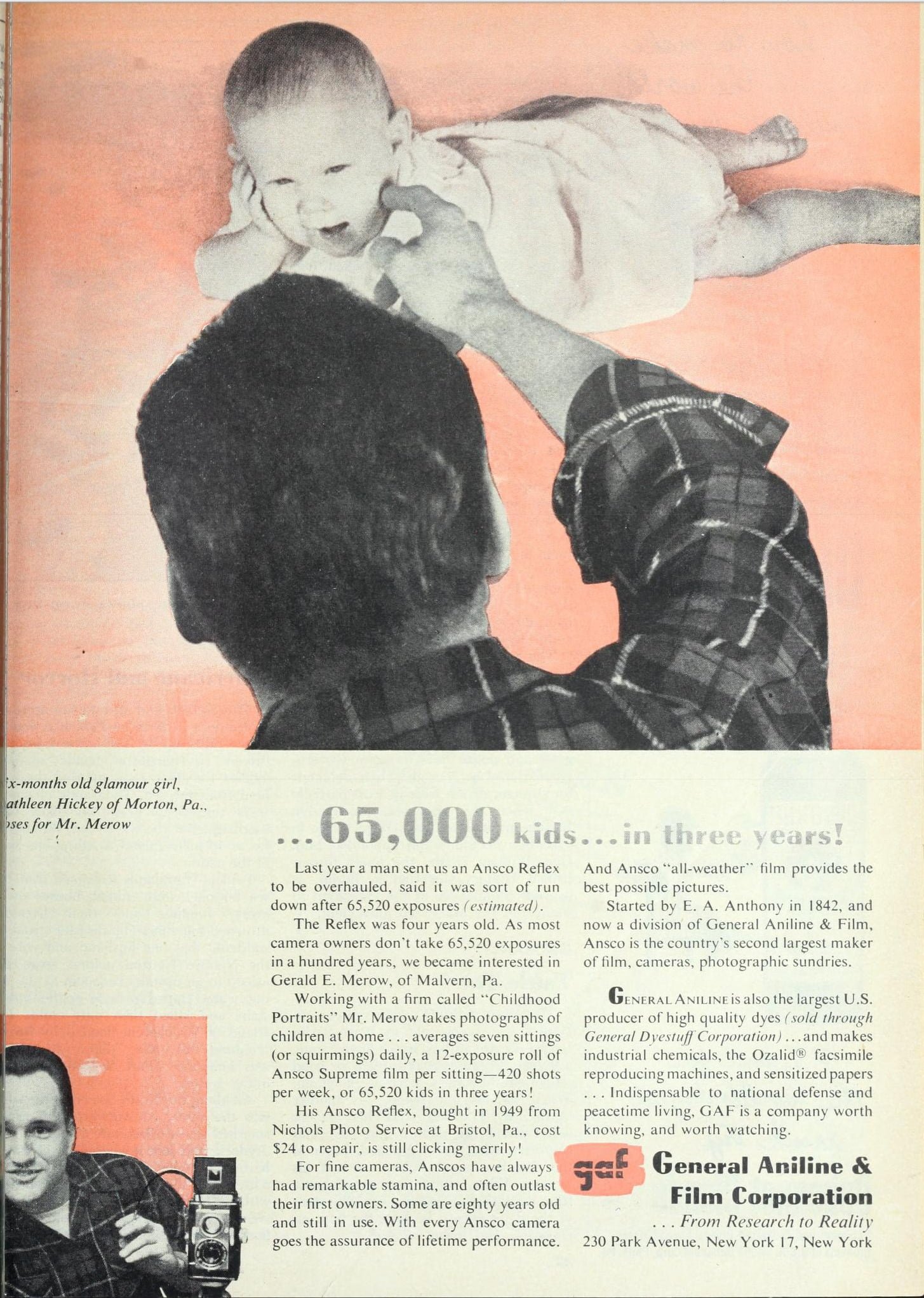
Even though Ansco had stopped making the Automatic Reflex, this story was interesting enough to turn into an advert for General Aniline. The estimated 65,520 exposures may be an exaggeration but it’s an interesting bit of history.
Here’s the copy from the advert:
65,000 kids … in three years!
Last year a man sent us an Ansco Reflex to be overhauled, said it was sort of run down after 65,520 exposures (estimated).
The Reflex was four years old. As most camera owners don’t take 65,520 exposures in a hundred years, we became interested in Gerald E. Merow, of Malvern, Pa.
Working with a firm called “Childhood Portraits” Mr. Merow takes photographs of children at home … averages seven sittings (or squirmings) daily, a 12 exposure roll of Ansco Supreme film per sitting — 420 shots per week, or 65,520 kids in three years!
His Ansco Reflex, bought in 1949 from Nichols Photo Service at Bristol, Pa., cost $24 to repair, is still clicking merrily!
For fine cameras, Anscos have always had remarkable stamina, and often outlast their first owners. Some are eighty years old and still in use. With every Ansco camera goes the assurance of lifetime performance.
And Ansco “all-weather” film provides the best possible pictures.
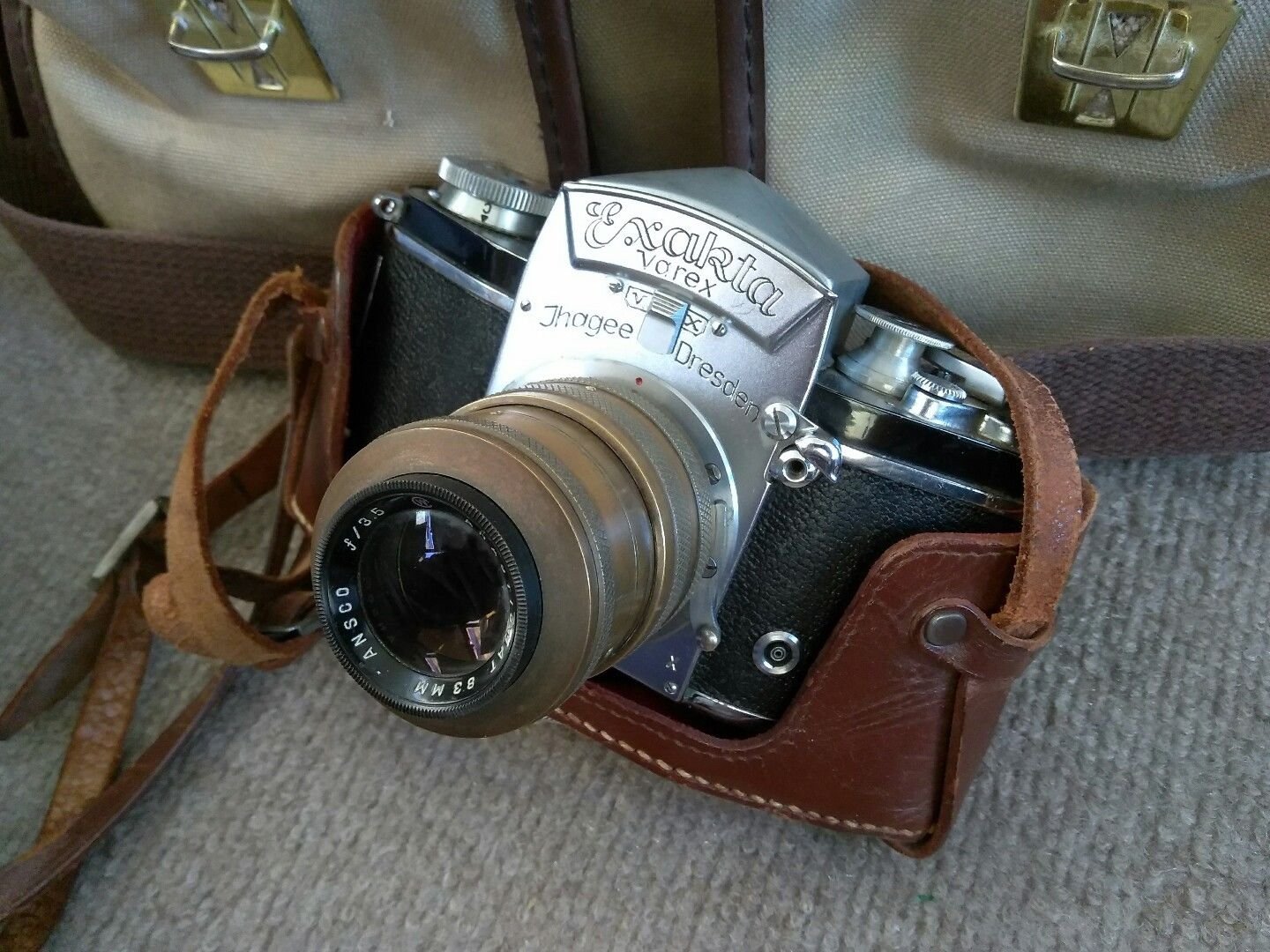
A unique and probably one-of-a-kind lens showed up on eBay in early 2018. The 83mm f3.5 Ansco Anastigmat lens (which is actually a Wollensak) was mounted in a brass barrel fitted with an Exakta mount.
The first auction posting showed just the lens. A subsequent post showed the lens mounted on an Exakta Varex.
No details, other than the photos, were available about the lens. The seller didn’t know anything of its provenance, so who or what prompted someone to make such a thing are unknown.
Ansco used Wollensak’s new Rapax shutter and a Wollensak lens in their Reflex. Ciro used the same shutter, and essentially the same lens, in several models of their Ciro-flex camera.
The Rapax featured flash synchronization from the start, according to an announcement in the May 1945 issue of American Photography. For whatever reason, Ansco didn’t implement the flash sync feature on their first round of Reflex cameras.
The new Rapax shutter, announced by Wollensak Optical Co., Rochester, features built-in automatic flash lamp synchronization and shutter speeds from one second to 1/400 second. A single click-stop allows the use of any popular flash lamp by selection of either a 5 or 20-millisecond position in the larger size shutters. 5 millisecond speed only with the smaller size shutters. The Rapax shutter is mechanically tripped by hand, thus the electrically controlled flashing of the lamp is the only drain on the battery. Flash peak and maximum shutter opening are synchronized by a precision built-in gear train. Entire production of the new shutter is being used at present by the armed forces.
The lack of a dedicated flash sync, although common on many cameras at the time, was frequently pointed out in the press at the camera’s introduction. Ansco added flash sync and offered a retrofit for existing owners. Based on one sample, the retrofit was a moderately labor intensive process.
The inner workings of the Reflex were reasonably well documented at the time of its release. Ansco released photos of the camera parts and assemblies to photography magazines, along with details of how the camera was assembled.
The camera itself is relatively simple. An aluminum casting makes up the main part of the body. The casting itself is lightweight.
Four brass guides, two on each side, are pressed and screwed into each side. A steel guide, attached to each side of the lens panel, glides along the V grooves of the brass guides. The bearings are greased, a grease that remains in good condition 70 years after it was applied. A cam follower pin, on both sides, engages with the cam in the focusing knob on both sides. Springs on the right side help with the “return” part of focusing.
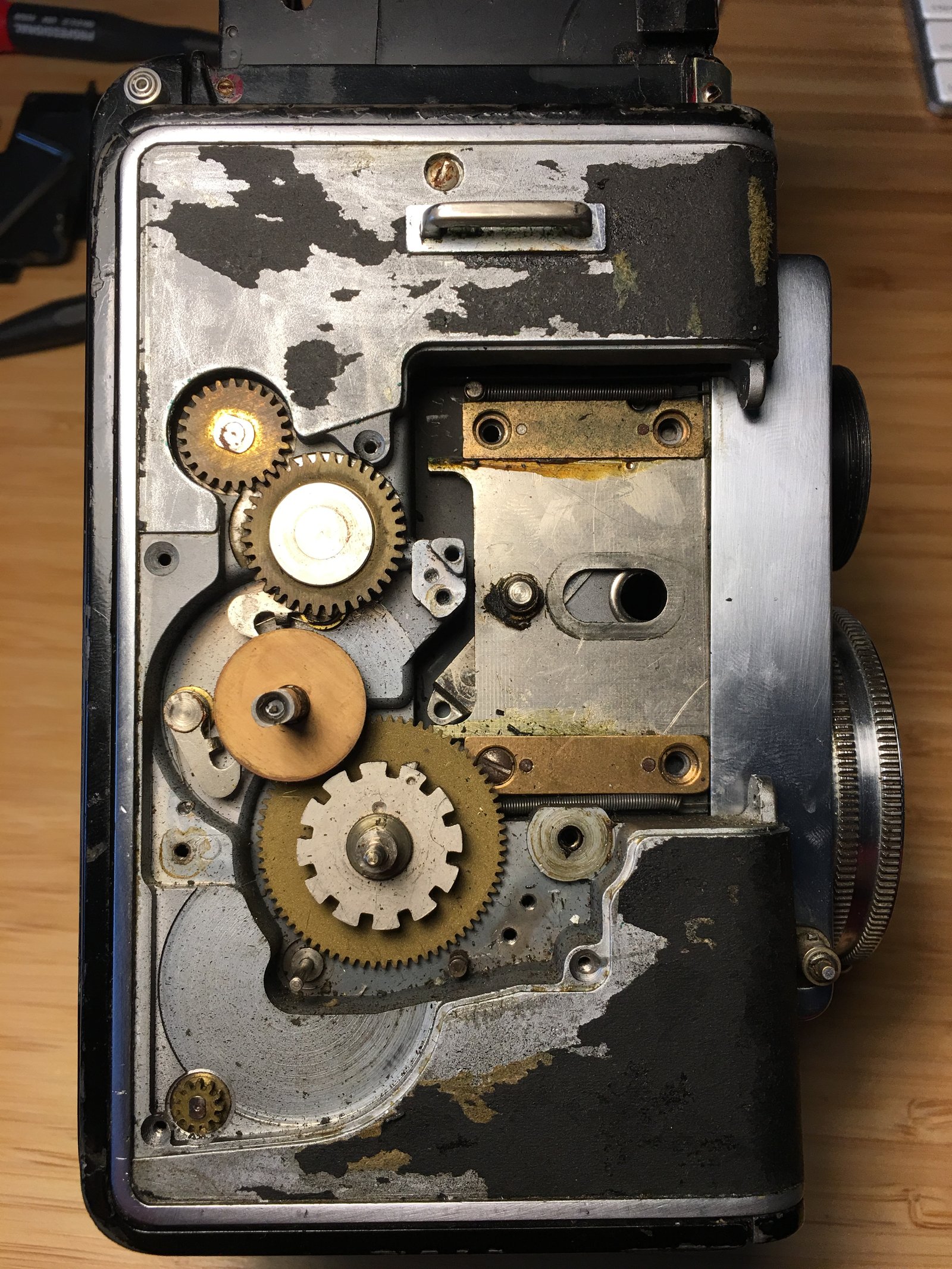

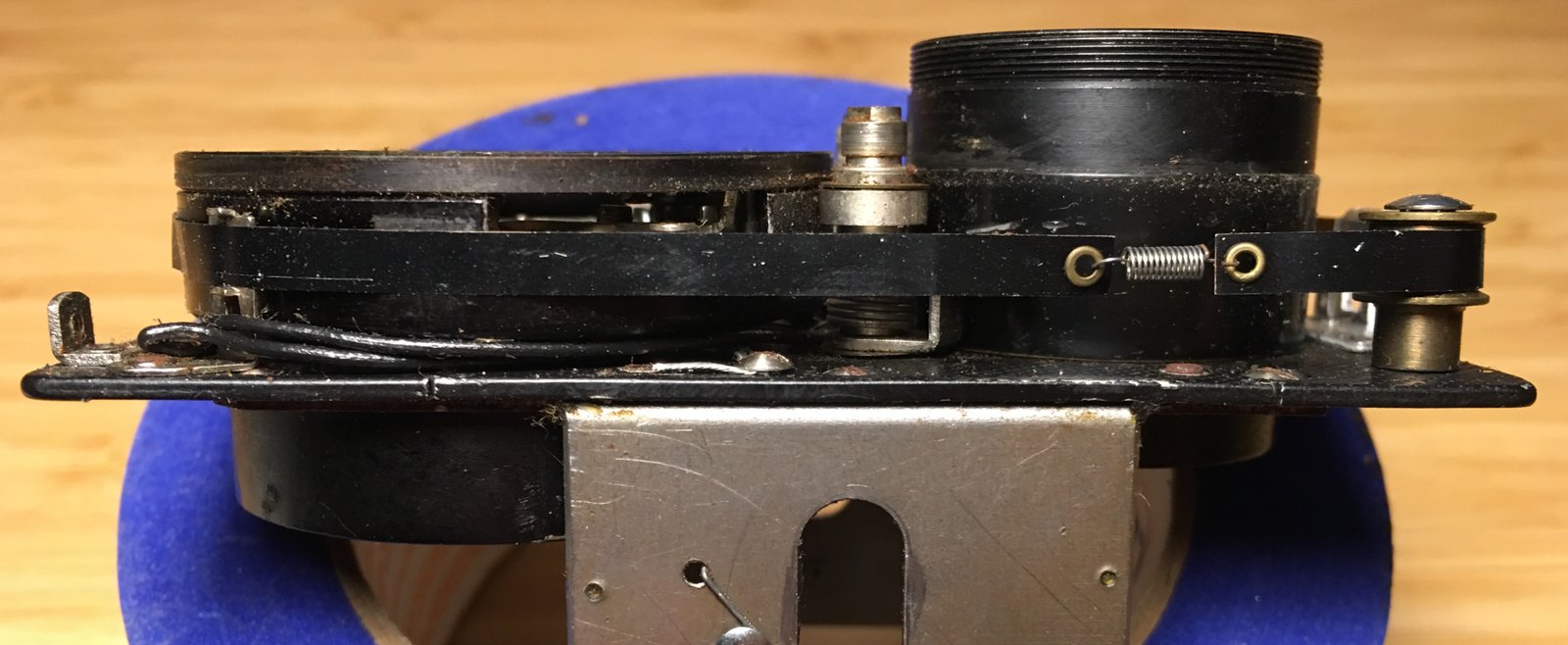
A Wollensak lens and shutter assembly are mounted on the lens panel. A thin metal belt, attached to the focus lever, transmits the aperture value to the window at the top.
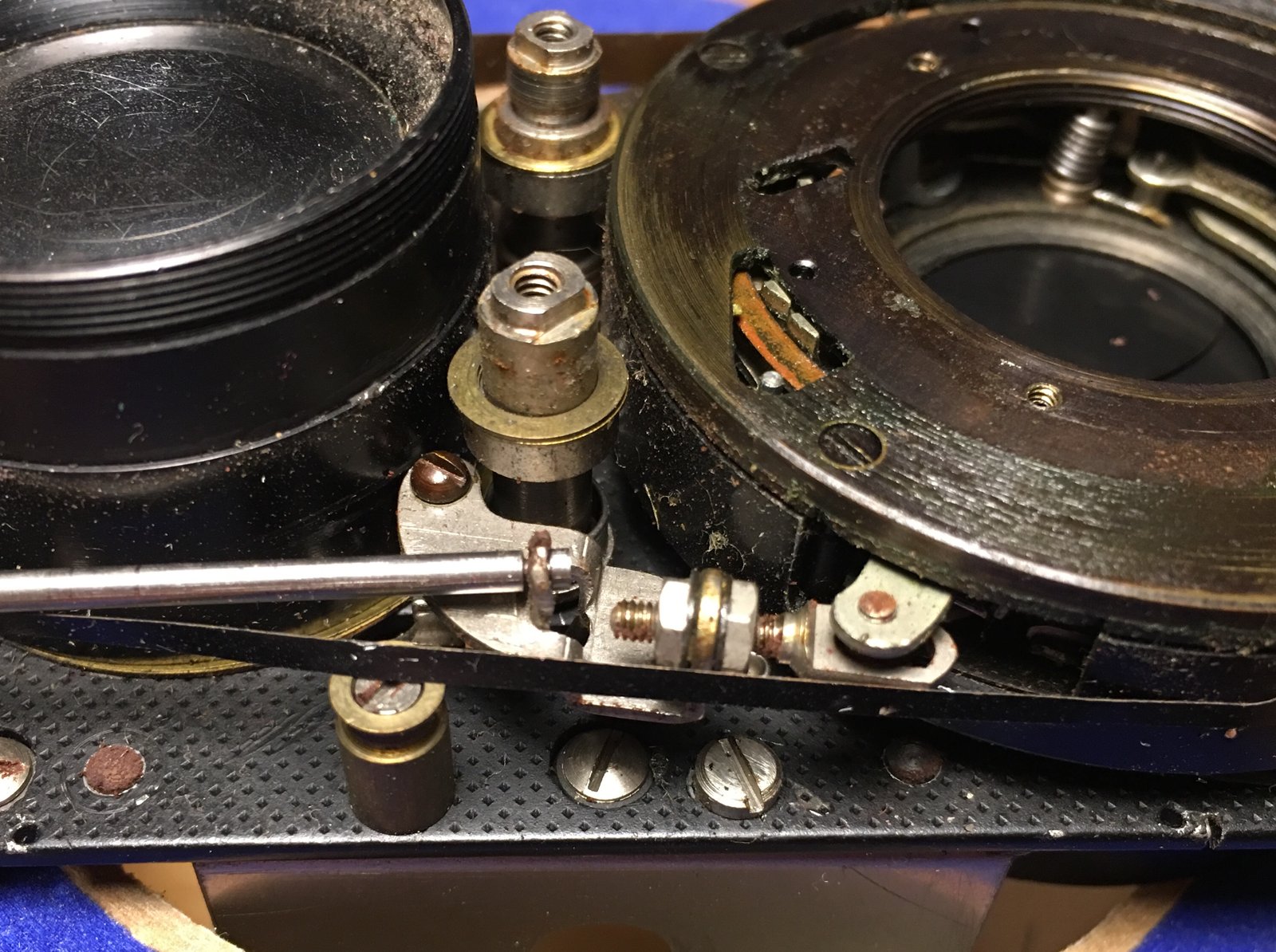
The shutter release mechanism is a little complicated, one that required fine tuning at the factory. The notorious interlock release, on the side of the camera, could do nothing to remedy a jam in the lens shutter itself. Such a jam would render a camera inoperable, like the example in these photos.
This particular Reflex started life as a type 1. Standoffs on the left and right side of the lens acted as guides for the shutter tape. The standoff on the right was drilled out for the flash connector standoff.

A wire, fed into the shutter, is soldered to the release post. Another wire is screwed to the baseplate of the lens panel, providing a ground for the flash sync.

The most tell-tale indicator of this retrofit is the machining of the shutter assembly. It’s clear that the opening for the flash sync is not original: it appears to have been ground into the case.
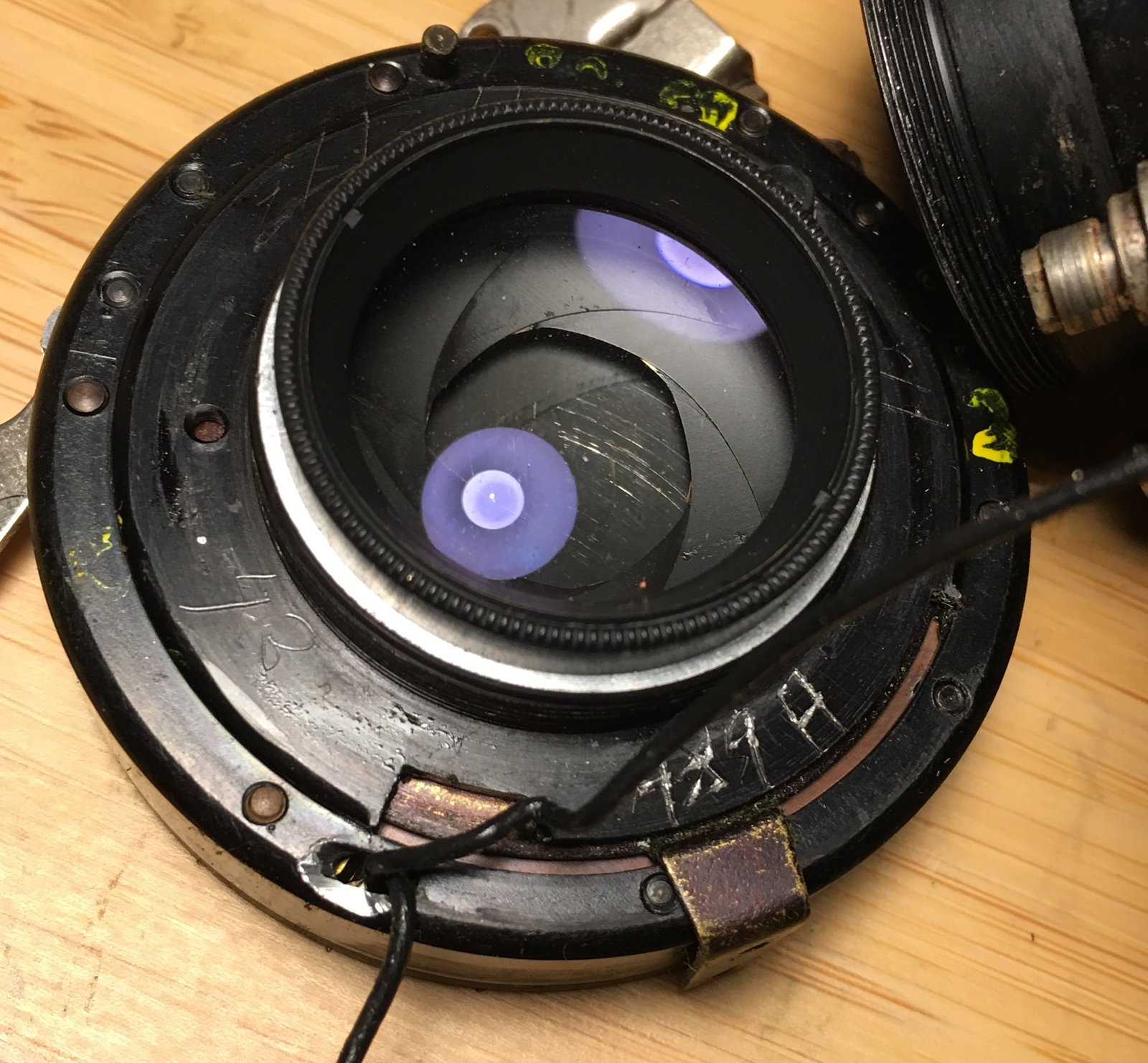
Inside the shutter, the sync connections are factory original parts. The Wollensak Rapax was designed with flash sync; apparently it was up to the camera manufacturer to decide if they’d use it.

What is clear, however, is how much work went into retrofitting flash sync to existing type 1 cameras. The side panels, along with the overlaying leather covering, had to be removed to gain the access necessary to remove the lens panel from the camera.
Upgrading a type 1 with flash sync requires removing the stamped cover and removing the lens unit from the lens panel. It is a near complete disassembly of the lens mechanism. At $24.50, the cost at the time, owners received quite a good deal.
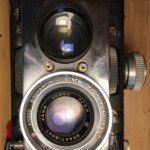

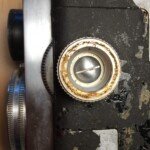

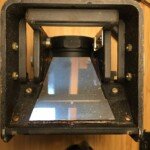
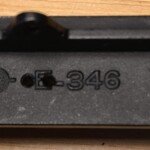

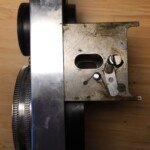
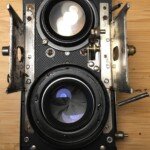

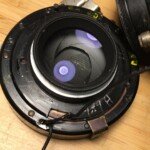

For the first time in more than four years new cameras are beginning to appear in the market. And almost without exception, the best of them are “Made In America.” World War II has given an impetus to a trend that began 20 years ago. No longer will photographers look abroad for the finest cameras and lenses. American manufacturers have not only equaled traditionally fine European equipment; in several ways they have surpassed it.
Outstanding among the new reflexes is the new Ansco luxury model, due shortly on the market. It’s a twin lens job, takes a dozen 2 ¼ x 2 ¼ negatives on 120 (B2) roll film. The taking lens is a coated f/3.5 Wollensak anastigmat with a focal length of 83 mm., and the cock-and-release-type shutter has speeds ranging from one-half to 1/400 second. The set and release controls are on the sides of the lens panel, and the shutter-speed markings can be read when the camera is in operating position. Other features are an all-metal body, automatic film transport, double-exposure prevention device, and eye-level optical view finder to supplement the ground glass.
American Cameras Step Out Pop Sci June 1946

Bridging the great gap between the more cumbersome press or studio equipment, and the less versatile amateur cameras, the precision-built twin-lens reflex offers many conspicuous advantages of both camera types. Combining candid-camera portability and view-camera ground glass focusing, the small reflex type of camera is preferred by many professional photographers, and magazine illustrators, as well as serious amateurs.
The Ansco Automatic Reflex f:3.5 Camera is the finest camera of this type made in America. In addition to bringing the photographer the obvious advantages of its excellent lenses and shutter, and those of focusing brilliant, negative-size images on it focusing screen, the new Ansco Reflex is the first American-made reflex camera to offer the long awaited automatic film transport plus dependable double exposure prevention.
It is apparent at a glance that the new Ansco Automatic Reflex is also a satisfying eyeful. The body is of long-lasting die-cast aluminum covered in rich, black morocco grain leather. All exposed metal parts, including the convenient calculator on the back, have a smooth, satin chrome finish. From its self-erecting finder hood to its firm, steady base, this camera is designed to please the most discriminating photographer.
Furthermore, the camera stands at the top of every comparison: rugged construction, operating conveniences, appearance, dependability and quality of the materials used. To give an example, the Automatic Reflex offers the operating refinements that you’ve dreamed of having in a camera, and its external precision controls are only the beginning of the story, for the interior mechanisms that you don’t see are equally impressive …
The sliding front lens panel has a wear-resistant suspension which gives the utmost rigidity and operating smoothness. Machine-cut gears are used throughout the tamper-proof film advance mechanism. Bearings and slides are self-lubricating for lifetime dependability. Quality is built into the new Ansco Reflex, right from the ground up!
In keeping with its construction features and other photographic refinements, the Ansco Automatic Reflex is equipped with optical elements of the highest quality and an accurate set-and-release shutter. The lenses are coated to reduce flare and internal reflections, and to produce photographs of great clarity and brilliance, either in black-and-white or color. Check the features below for overall excellence, efficiency, and operating convenience.
The taking lens is a coated Ansco f:3.5 Anastigmat 83mm in focal length, with a matched coated f:3.2 finding lens. Both of these lenses are carefully made to an exact formula, and are thoroughly tested, both before and after being mounted on the camera. The 83mm focal length gives ideal working distances and angle of coverage for the 2 1/4″ x 2 1/4″ negative size.
The lens elements remain in fixed position in relation to each other at all focusing settings in order to take full advantage of the exact lens formula. The lenses are excellent for color photography as well as black-and-white work.
The Ansco Automatic Reflex shutter is a precision cock-and-release type which gives accurately measured exposures from a full second to 1/400 second, and Bulb. This between-the-lens shutter is cocked by merely pressing the handy lever on the left side of the front lens panel; it is released by pressing the conveniently placed lever at the right side of the front panel.
Those who may raise the question, “Why isn’t the camera made so the automatic film advance will cock the shutter?” should remember that such a mechanism places an immediate stress upon the delicate springs within the shutter. Though these springs are of the highest quality, it is obvious that they cannot be held always under tension between exposures — which may be hours, days, or even weeks apart — without ultimately impairing the accuracy of the shutter and shortening its useful life.
The shutter speed of the Ansco Reflex is selected by turning the barrel of the taking lens. The effective shutter setting automatically appears at the top of the finder lens mount, where it is easily readable fro the normal picture-taking position.
The cable release socket provided at the top of the lens panel is connected by direct drive to the original trigger lever inside the shutter. Thus, any conventional type of flash gun, including multiflash and high-speed electronic flash units, may be used with every assurance of exact and efficient synchronization.
The diaphragm is set by moving a convenient control at the bottom of the taking lens mount. The lens aperture setting automatically appears in the aperture window at the top of the front panel, where it is readable from the conventional picture-taking position. The aperture setting may also be read from the mount of the taking lens opposite the control.
The Ansco Automatic Reflex is the first American reflex camera to offer the convenience of automatic film transport. With this feature, a simple twist of the folding chrome crank on the right side of the camera automatically advances the film exactly one frame, at the same time releasing the double exposure prevention mechanism. This rapid method of advancing the film will speed up shooting and prevent negative losses due to double exposures.
As the film is advanced, an automatic counter brings the number of the succeeding exposure into view under a transparent plastic window next to the film advance crank. All mechanism is under cover, and sealed off from the damaging effects of dust and grit.
The automatic film transport releases the double exposure prevention device as the film is advanced. This positively prevents accidental exposures, although there is a provision for multiple exposures if the photographer cares to make them.
One other exclusive feature of the Ansco Automatic Reflex lies in a small resetting lever on the right side of the camera, adjacent to the exposure counter.
If multiple exposures are desired, simply push the magic lever; this releases the double exposure prevention device, allowing the shutter to be released again without advancing the film.
If you want to wind off a partially exposed roll of film, press the resetting lever and turn the exposure counter to “N.” The complete roll may then be quickly round off without further attention.
In addition, this lever will clear almost all the camera mechanism should it become jammed through improper manipulation. It represents a feature which may circumvent repairs.
The ground glass focusing screen allows the photographer to compose his pictures exactly as they will appear on the negative, thus utilizing the total negative area. Focusing is also easier and simpler with the advantages of this full negative-size focusing screen.
The self-erecting finder hood shields the ground glass focusing screen from stray light, making for brilliant images which are easy to see. The pressure of a finger on a single point brings the hood quickly into position.
Photographers will be glad to learn that the hood of the Ansco Reflex can also be closed in a like manner — by the pressure of a finger on a single point. No folding of the sides is necessary.
Razor-sharp focusing is easy with the built-in focusing magnifier ready to spring into position over the ground glass at a touch of a button. This button is located outside the self-erecting hood — there is no danger of fingerprinting the focusing screen or the magnifier.
If the photographer wishes to use an eye-level view finder, he will find that the front and back panels of the Ansco Reflex focusing hood contain a high quality optical sports finder. This direct view finder, an integral part of the camera, is extremely valuable when photographing fast action or whenever the camera must be used at eye level.
The subject is easily brought into focus on the negative-size ground glass screen by rotating the knurled knob on the left side of the camera. This grip-sized knob moves the entire lens assemblies smoothly forward and backward for critical focus at any distance from 3’8″ to infinity, always taking advantage of the exact formula at all settings.
An easy-to-read footage scale is engraved on the focusing-knob for fast focusing when using the direct optical finder. It is an excellent focusing guide for action shots where speed in shooting is essential.
The entire lens assemblies are moved by turning the focusing knob to obtain exact focus; no individual element is disturbed from its critical relationship to the other elements of the formula.
The rack-and-pinion system has been discarded in favor of the precision-ground cam mechanism. Using the cam principle for moving the lens assemblies forward and backward has advantages from both the standpoints of wear and precise operation. The cam mechanism is built for lifetime wear, and will give years of velvet-smooth trouble-free operation, due to its self-lubricating precision slides.
There is provision for finger-tip focusing with either or both hands should the photographer desire to use it. Focusing wheels on both sides of the lens panel are coupled by direct drive to the focusing knob for hairline accuracy of operation.
All controls and adjustments are instantly visible from the overhead view conventionally used when operating the camera; the photographer may check the shutter speed and aperture setting as he examines the image in the ground glass — all without changing his position or moving the camera.
Construction features such as a die-cast aluminum body, and heavy-duty precision-machined gears, make the Ansco Automatic Reflex America’s best built reflex camera. Examine this camera’s many outstanding construction features, and see for yourself why you can expect the Ansco Reflex to give you years of trouble-free accurate operation:
The Ansco Reflex measures only 3 1/4 x 4 1/4 by 5 3/4 inches, presenting a remarkably compact instrument that is easy to carry even when the going is rough.
Weight, as well as bulk, has been reduced to a minimum. Weighing 2 lb. 12 oz., the camera is firm and steady in the hands, yet light to carry.
Long-lasting, velvet-smooth operation is assured by a dependable precision-ground slider suspension. Four self-lubricating slides (two on each side) firmly support the lens panel carriage which is driven by direct drive on both sides. It has the utmost rigidity, and is not subjected to torque when operated. The costlier cam and precision slide principle means added years of dependable camera performance.
Light in weight and long on durability, the die-cast aluminum body renders the camera as invulnerable to injury as is possible to make it. And this is not the only casting used in the Ansco Automatic Reflex, for no less than six precision aluminum castings are used in every camera.
The high quality genuine leather body covering has a generous quota of eye-appeal. And it not only looks well, it wears well, and will keep its luxurious appearance over the years.
All exposed metal parts on the Ansco Reflex have a satin chrome finish. These parts will give lifetime wear and will not tarnish.
Precision parts are used throughout the camera; gears and other moving parts are machine-cut to exact dimensions. Punch-press gears stamped out of metal were not precise enough to go into the Ansco Reflex. In addition, parts exposed to heavier strains and wear are hardened to maintain the accuracy and alignment of all assemblies.
Although it is probably that photographers would never encounter trouble even if these bearings were not used, Ansco engineers wanted to give the Automatic Reflex owners the finest instrument possible. As a consequence, bronze bearings are pressed into the aluminum casting at points of wear.
All bearings and slides are self-lubricating for years of trouble-free smooth operation. Wear on moving parts is, of course, reduced to a minimum.
Safety catch locks are incorporated with the film spool stud supports as another construction refinement of the Reflex. This is a very important feature to the photographer, for it means he cannot accidentally disengage the film spool from its supports while the camera back is closed; there is no danger of film loss while on assignment. Opening the camera back automatically releases these locks, and the film is quickly removable without any adjustment of them.
Especially designed to protect your Ansco Reflex from wear and possibly injury. Made from genuine top grain split cowhide, lined with soft leather for greater beauty and durability. The case may be carried by the convenient hand strap, or suspended from the shoulder by the extension strap which is also provided.
Many other accessories of superb quality and workmanship are custom made for the Ansco Automatic Reflex. Filter holders and sunshades especially designed for the 33mm taking lens mount are available, as are various filters of the highest optical quality.
Ansco Automatic Reflex f:3.5 Camera … $225.00
Federal Excise Tax … 37.50
Total … $262.50
Ansco Reflex Carrying Case … $12.50
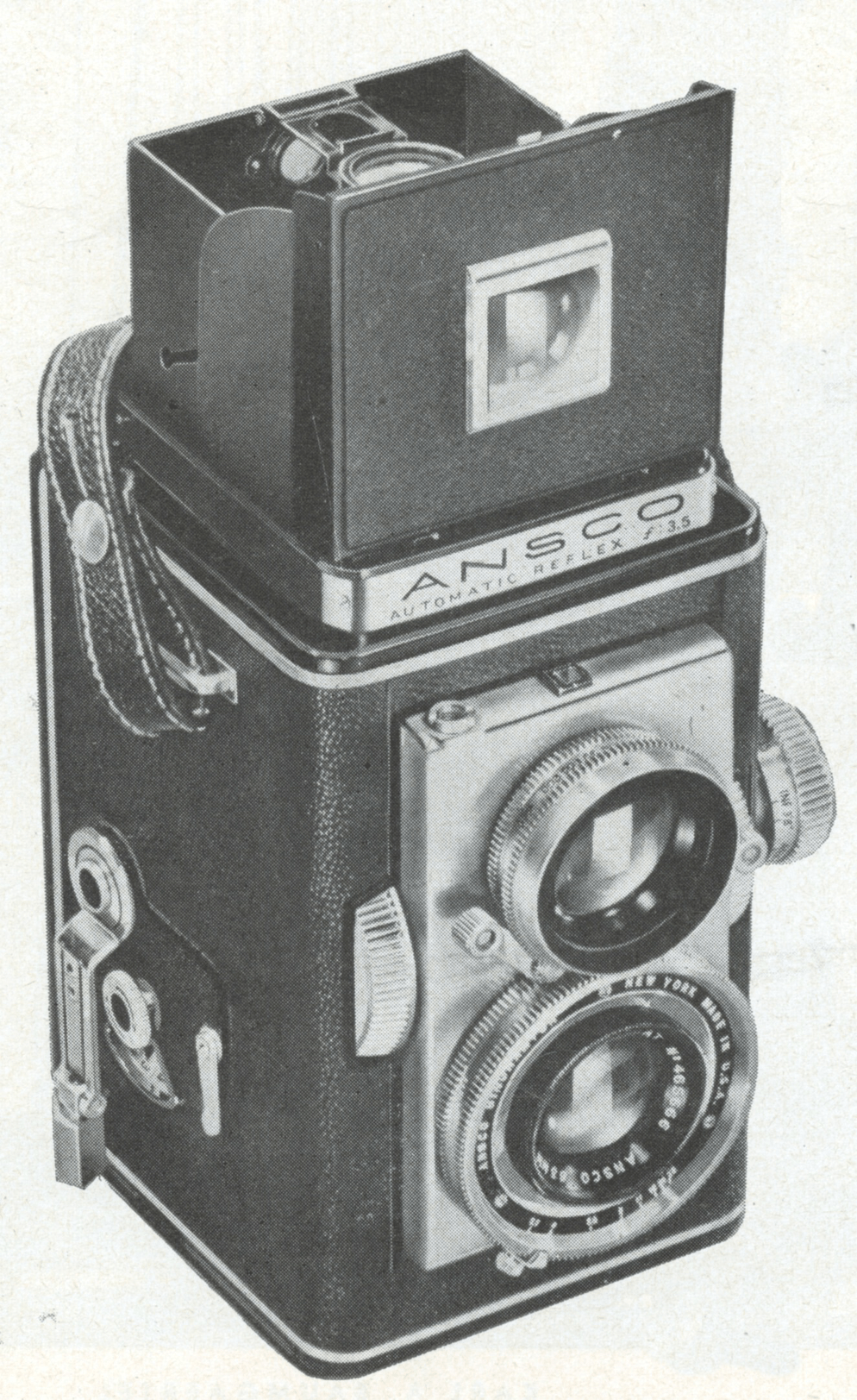
By Dave MacFie
During the last decade the twin-lens reflex type of camera has skyrocketed in popularity with amateur and professional photographers alike. This has been due not only to the quality of pictures it produces, but also to the general excellence of design and construction of the original “Rollei” models, along with other quality imported cameras.
Foreign cameras, however, are not so plentiful as they once were, and it is doubtful if they will ever again be available in pre-war quantities at pre-war prices. Of the several American camera manufacturers who have designed twin-lens reflex cameras to fill the needs of amateur and professional photographers, Ansco has produced the most ambitious model to date.

The Ansco Reflex is a precision-built twin-lens reflex camera which takes twelve exposures 2¼x2¼” square on a roll of 120 film. With a chrome-satin on all metal parts and the body covered with black morocco grain leather, it is an attractive, compact camera measuring 3¼ x 4¼ by 5¾” in size. Completely assembled, its weight is 2 pounds, 12 ounces. (As compared with the average Rolleiflex, Ikoflex, etc., the Ansco Reflex is slightly larger and weighs 8 to 10 ounces more. — Ed.)
In addition to the usual advantage offered by reflex cameras — namely, ground glass focusing with all images appearing right-side-up the same size they will be in the negative, the Ansco Reflex features an automatic film transport and a device designed to prevent accidental double exposure. All controls and settings are visible from the normal picture-taking position so that shutter speed, aperture setting, and the focus can be checked without shifting the camera.

Eight non-shattering aluminum alloy castings form the basis for the Ansco Reflex Camera. These parts have been cast with such precision that they will remain assembled together even without using means of joining them.
A loose, wobbly lens panel has been one of the chief mechanical faults to develop in some types of reflex cameras. To insure the Ansco Reflex lens panel retaining its original alignment over a period of years, a precision-ground slider principle has been incorporated. The panel is suspended by four self-lubricating grooves, two on each side, and driven simultaneously by cams on both sides. A firm, four-point suspension assembly, and the elimination of torque, help make this type of mechanism resistant to wear. Although the cam and precision slide principle is more expensive than the rack-and-pinion mechanism, more commonly used, it is believed by the Ansco people that the advantages gained are worth the extra expense.

Gears and other moving parts in the camera are machine-cut to exact dimensions instead of being turned out on punch presses. Parts exposed to heavier strains and wear are hardened so that accuracy of all assemblies will be maintained. Bronze bearings have also been used wherever necessary to heighten the wearing qualities. Don’t strain your eyes looking for these bronze bearings because they are the proverbial “no see-’ums” — but they’ve been pressed into the aluminum alloy at strategic points to extend the life and dependability of the camera.
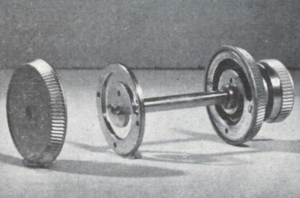
Another small but important feature lies in the safety catch locks on the spool stud supports. These locks make certain that the photographer cannot inadvertently disengage the spool from its supports while the camera back is closed. Since these locks are automatically released when the camera back is opened no attention need be given to them.
Optical elements of the best quality have been used, and the lenses have been coated to reduce flare and internal reflections. A precise set-and-release shutter gives accurately measured speeds ranging from 1 second to 1/400 sec.
The taking lens is a coated Ansco f:3.5 Anastigmat, 83mm in focal length. An 83mm lens does not produce an abnormally shallow depth of field, yet it gives good coverage over the whole negative area right up to the corners. This is of particular interest to photographers who know the importance of getting top-quality over-all color transparencies.
The matched finder lens is an f:3.2 designed to provide greater brilliance of the reflected images on the ground glass focusing screen. There is further significance to the wider aperture of the finder lens than increased brightness of the ground glass; it also gives photographers a slight leeway for focusing errors, even at maximum aperture. lf focusing is accurate at f:3.2, it stands to reason that it will be correct for the taking lens, even when it is set at f:3.5. Both lenses are, of course, ground to exact formula and fully tested both before and after mounting. The entire lens assembly moves smoothly forward and back to take full advantage exact lens formula.
The taking lens is 33mm in diameter. Thus, any suitable accessories which this size of mount (such as Series VI adapter rings) may be used although accessories especially designed for the Ansco Reflex will soon be available.

The automatic film advance is not coupled with the shutter cocking mechanism. Since it is a habit with most photographers to advance the film immediately following each exposure, the shutter springs would be held constantly under stress (save during the short intervals between tripping the shutter and advancing the film) if the Reflex film advance and shutter-cocking mechanisms were coupled to operate simultaneously. Placing the delicate shutter springs under prolonged tension has been avoided in order to make certain that the life and accuracy of the shutter will not be impaired.

Synchronization for flash photography presents no problem. The cable release socket at the top of the lens panel is connected by a direct drive shaft to the trigger level within the shutter. There is only one straight shaft with no linkages to complicate synchronization. Most standard types of flash guns, including high-speed electronic flash units as well as multi-flash, may be used on the new Reflex.
The shutter speed is selected by rotating the barrel. This, in turn, rotates the mount of the finder lens so that the shutter speed being used automatically appears engraved on the top side. The aperture is set by moving a small lever at the bottom of the taking lens opposite the appropriate “f” number. An endless metal band under spring causes the selected aperture to appear in a small window located on top of the lens panel. As mentioned before, all adjustments are visible from the overhead view normally used in operating a reflex camera.
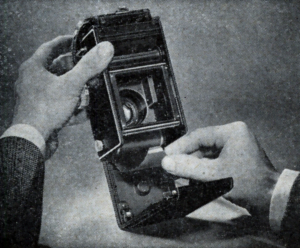
The Ansco Reflex can be loaded quickly. The camera back opens easily by pressing the two release buttons which are located near the top of the camera back. As the back opens, the safety catch locks on the spool supports are released.

Minicam’s Editors had the opportunity of testing one of the first Ansco Reflex cameras the assembly line. Each editor made individual tests and listed only his adverse criticisms of the camera. These criticisms were later correlated into questions and presented to Ansco’s Amateur Camera Department at Binghamton, N. Y. for answering.
The sole purpose in raising these questions was to Minicam readers a more complete picture of the Ansco Reflex. Minor adverse criticisms notwithstanding, the Editors are of the unanimous opinion that the Ansco Reflex is a excellent precision instrument.
Q. The Ansco Reflex has provisions for Bulb exposure, but no Time exposure. Why?
A. Time exposures could not be operated with the presently designed double exposure prevention device. For this reason, no time exposure appears on the shutter. It is, of course, possible to make time exposures with the time-bulb cable release that employs a knurled locking feature for time exposures.
Q. Why must two levers be used each time an exposure is made — one lever to cock the shutter, another to release it? Why not use one lever for both operations like some of the other reflex cameras incorporate?
A. This cannot be done without a radical redesign of the shutter. The single lever operation cannot be directly applied where means of double exposure prevention are supplied.
Q. The camera is covered with protruding knobs and is somewhat difficult to place in an accessories kit for this reason. Couldn’t some of these ratchets and knobs be fitted more closely to the camera body?
A. The advance ratchet and double exposure release are now placed so close to the body that they will rub the leather if operated carelessly. It should be noted that the focusing knob on the side of the camera can be removed and replaced with a large, flatheaded screw which we will supply. Focusing would then be done by rotating the two milled knobs at the front.
Q. Why are the lens gears exposed so openly? Isn’t this an invitation to grit and dust gathering?
A. This is a question of design policy. It should be noted that a number of other popular cameras incorporate open gearing. Open gears can be observed and will be cleaned oftener than those which are enclosed. It is impossible to make such entirely dust-proof.
Q. Are all the bugs ironed out of the double exposure release lever?
A. Through improper manipulation it is possible to “lock” any of the more elaborate cameras on the market today. The Ansco Reflex is no exception to this. A customer using this type of camera should thoroughly familiarize himself with the instruction manual and routine before operating the camera. We supply each camera with a dummy roll of film to facilitate this requirement.
(The double-exposure release seems to be extremely delicate. For us, with several different cameras, the works were suddenly “locked” for no reason we could fathom. Although clicking the double-exposure release instantly restored these cameras to normal operation, we felt that the double-exposure release was a little trick at times.-Ed.)
Q. Why doesn’t the center panel of the hood flip up out of the way for action shots sighted by eye? The brilliant view-finder, of course, is provided for this purpose, but isn’t it something more or less of an afterthought gadget?
A. It would have been much simpler and somewhat cheaper to supply a fame type finder, such as was suggested. The optical view finder, as furnished on the Ansco Reflex, is more expensive to produce and was definitely not provided as an afterthought. Its inclusion was the result of an extensive survey of qualified camera owners, the majority of whom requested the inclusion of this type of direct view finder.
Q. In focusing, the speed wheels have a desirable tension as the lens is racked away from the camera body. But there is little or no tension (drag) when the rack is moved back towards the camera body. What is the advantage of the free backward movement.
A. The model commented upon is obviously not in correct working order in this respect. There is tension on the lens rack movement at all times.
(Tests on later models substantiates this answer. — Ed.)
Although some critics have objected to the size and weight of the Ansco Reflex, Minicam’s Editors did not find these points objectionable, due, perhaps, to the fact that the camera is extremely well balanced.
MacFie, Davie. “The New Ansco Automatic Reflex.” Minicam Photography Feb. 1948: 30-35-137. Print.